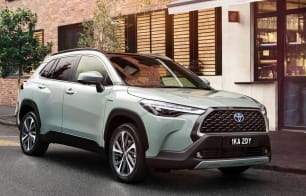The cabin of the new GX 550 is fairly practical with plenty of head- and legroom in each row (yep, even the third!). When you first hop in, it can feel a big snug on elbow-room but this feeling quickly dissipates.
Despite a 215mm ground clearance, access is pretty good for the front and middle rows due to the wide door apertures and side-steps. Third row access is a bit awkward for an adult but my eight-year old loved scampering back there this week.
The electric front seats are comfortable with their extra functions and I like the way the massage feature extends to the seat cushion as it limits fatigue on longer journeys. However, you sit on top of them rather sink into them which makes it feel a little trucky at times.
The wide middle row has a bench seat that will be comfortable for kids but an adult might get a sore behind on a long trip. The transmission tunnel also compromises foot room for adults but the seat is wide enough to make use of all three top-tether anchor points (there are ISOFIX mounts too).
It was a little bit of an effort to lift my big booster seat into the back because the GX 550 sits so tall but otherwise, there's plenty of room around a child seat for them not to feel like a sardine.
Individual storage is made up of a glove box that fits an owner's manual, a small shelf in the dashboard and a middle console that doubles as a cool box (mini fridge) and can fit up to four cans or bottles in it.
Each row gets four drinkholders and two USB-C ports but the front also enjoys a 12-volt socket and wireless charging pad. There's a 220V domestic plug port in the boot for larger appliances, too.
It's sometimes awkward to use the wireless charging pad because it's easy for your phone to slide around on it and it quite often disengaged from charging.
My son enjoyed all of the other amenities in the middle row, like the reading lights, climate control, two USB-C ports and retractable sunblinds and I applaud carmakers when they position rear directional air vents in the pillars and/or roof. It just makes it so much easier to cool down sweaty kids!
The 14-inch multimedia display has clear graphics and a responsive touchscreen. The layout is easy enough to get used to after spending some time with it and the sat nav is simple to use.
I like that the sat nav directions can be pulled into the 12.3-inch digital instrument cluster and head-up display.
There is a Lexus connected services app, which you get a three-year subscription to. It's easy to connect to the wireless Apple CarPlay and there is also wireless Android Auto.
The system also has Bluetooth and digital radio, which is a delight to use through the 21-speaker Mark Levinson sound system.
The cabin is rounded out by the well-shaped boot which has a massive 1063L of capacity when the third-row is folded. That's been more than enough for my family's needs this week and my German Shepherd was pretty comfy back there, too. The powered tailgate has a kick-function and there is a full-size spare wheel underneath the car.






